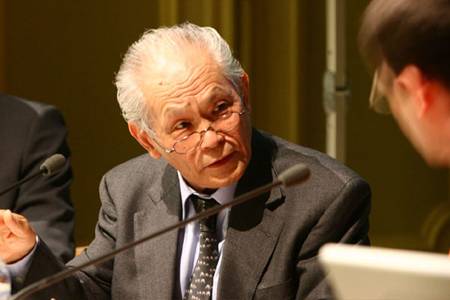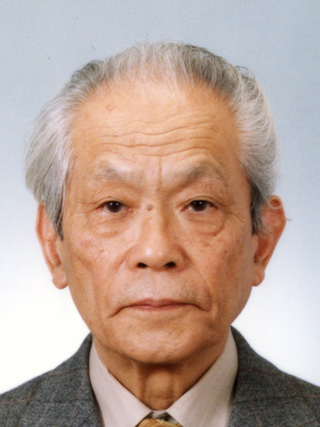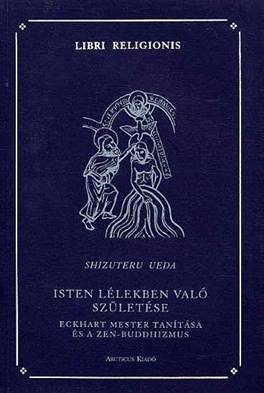ZEN MESTEREK ZEN MASTERS
« Zen főoldal
« vissza a Terebess Online nyitólapjára

上田閑照 Ueda Shizuteru (1926-2019)
京都学派 Kyōto-gakuha / The Kyoto School / Kiotói-iskola

Ueda Shizuteru is the central figure of the third generation of the Kyoto School.
A student and successor of Nishitani Keiji and a foremost interpreter of Nishida
Kitarō, Ueda inherited their commitment to bringing western philosophy and religion
into dialogue with the practice and thought of 'Mahayana’ Buddhism. The
son of a 'Shingon’ Buddhist scholar, Ueda himself, like Nishida and Nishitani,
has engaged in an intense and prolonged practice of Zen. His involvement in a group
for lay practitioners at Shōkoku-ji monastery in Kyoto continues to this day with
the monthly talks he gives on the classical texts of the Zen tradition. In the course of
his academic work, however, he turned explicitly to Zen only after first pursuing
studies in western philosophy (initially Kant and Hegel and then focusing on Hei-
degger and other existentialists and phenomenologists) and Christian mysticism
(primarily Meister Eckhart). After spending three years (1959-1962) at Marburg
University, he completed a doctoral dissertation in German on Eckhart's thought.
Ueda's linguistic versatility and experience—his strong competence in German and
in other European languages as well as in classical Chinese, are all evident in his
reflections on language.
By way of exploring the profound resonances as well as certain differences between
Eckhart and Zen, Ueda began increasingly to write from and about the standpoint
of Zen. A central and persistent concern of his has been the relation between the
experience of Zen and the rational thinking of philosophy. This concern was taken
up in his interpretations of Nishida, who had begun by attempting to develop a
philosophy of "pure experience" both as that which precedes the subject-object
split with all linguistically mediated deliberations, and as that which engenders and
dynamically unifies all the divisions and articulations of reality. Following Nishida,
Ueda came to locate language in a philosophy of 'place', that is, in a topologically
layered conception of reality. He often explains the relation between experience and
language according to a three-tiered model: (a) the prelinguistic and protolinguistic
level of pure experience; (b) the level of rudimentary phrases in poetic-religious
expression; and (c) the level of philosophical and worldly discourse.
For Ueda, what lies beyond the reach of language is not to be understood as
an ineffable realm to which one ascends and remains, but rather is to be experi-
enced in extreme moments from the limits of language as that which at once tears
through and mends, exceeds and encompasses, transcends and transforms our
linguistic worlds of meaning. He agrees with Heidegger that human being is not a
self-encapsulated ego but rather a being-in-the-world. And yet, he insists, the world
is essentially twofold: the world of linguistically mediated and articulated meaning,
in which our daily lives are located, is in turn located within a hollow-expanse that
transcends and envelops this world. This hollow-expanse is beyond conceptual
understanding, insofar as concepts have as their medium the world of language
and its determinations of meaning. Nevertheless, certain forms of language, namely
what Ueda calls the "hollow words" found, for example, in poetry and Zen sayings,
can attune us to this ultimate place in which our lives are located. Insofar as we do
not close in on ourselves and rigidify our linguistic delimitations of the world, we
can open ourselves up to the silence of this surrounding expanse of unlimited open-
ness, which in turn allows us to speak and act more freely and responsibly in the
world of linguistic actuality.
PDF: Approaching the Ueda Shizuteru Collection &
Works of Ueda Shizuteru published in Western languages
by
James W. Heisig
Review of
Ueda Shizuteru shū [Collected Writings of Ueda Shizuteru], Tokyo: Iwanami, 2001–2003.
https://nirc.nanzan-u.ac.jp/en/files/2012/12/JWH-Ueda-senshu-review.pdf
PDF: The Place of Man in the Noh Play
by Ueda Shizuteru
In The Eastern Buddhist 25, no. 2 (1992): 59-88.
PDF: Ascent and Descent: Zen in Comparison with Meister Eckhart, I-II
by Ueda Shizuteru
The Eastern Buddhist. New series,16(1), Spring 1983, pp. 52-73
Translated by James W. Heisig
The Eastern Buddhist. New series,16(2), Autumn 1983, pp. 72-91
Translated by Ian Astley and James W. Heisig
PDF: Tetsugaku Companion to Ueda Shizuteru: Language, Experience, and Zen
Editors: Ralf Müller • Raquel Bouso • Adam Loughnane
2022, Corrected Publication 2023.
“Nothingness” in Meister Eckhart and Zen Buddhism
in The Buddha Eye: An Anthology of the Kyoto School and Its Contemporaries, edited by Frederick Franck, World Wisdom, Inc, 2004, pp. 157-170.
Ueda, Shizuteru, “Nothingness in Meister Eckhart and Zen Buddhism with Particular Reference to the Borderlands of Philosophy and Theology,” in Transzendenz und Immanenz: Philosophie und Theologie in der veränderten Welt, ed. D. Papenfuss and J. Söring (Berlin, 1977), trans. James W. Heisig.
http://www.worldwisdom.com/public/viewpdf/default.aspx?article-title=%E2%80%9CNothingness%E2%80%9D%20in%20Meister%20Eckhart%20and%20Zen%20Buddhism.pdfUeda, Shizuteru, O nada absoluto no Zen em Eckhart e em Nietzsche
Nat. hum. v.10 n.1 São Paulo jun. 2008
http://pepsic.bvsalud.org/scielo.php?pid=S1517-24302008000100008&script=sci_arttext
Silence and Words in Zen Buddhism
Diogenes, No. 170, Vol 43/2, Summer, 1995
http://www.thezensite.com/ZenEssays/Philosophical/Silence_and_Words.html
Entangling Vines
A Classic Collection of Zen Koans by Thomas Yuho Kirchner. Foreword by Nelson Foster, Wisdom Publications, 2013, 352 p.
Introduction by Ueda Shizuteru
PDF: Expressing Experience: Language in Ueda Shizuteru’s Philosophy of Zen
by Bret W. Davis
In: Dao Companions to Chinese Philosophy, Volume 8. 2019, Pages 713-738.
PDF: The Legacy of Ueda Shizuteru: A Zen Life of Dialogue in a Twofold World
by Bret W. Davis
Comparative and Continental Philosophy, Volume 14, 2022 - Issue 2: pp. 112-127.
PDF: The Self that Is Not a Self in the World that Is Twofold. The Thought of Ueda Shizuteru.
by Steffen Döll
Chapter 22 In: The Oxford Handbook of Japanese Philosophy, ed. by Bret W. Davis, 2020
PDF: Contributions to Dialogue with the Kyoto School
by Ueda Shizuteru
Translated from the Japanese by Bret W. Davis
Chapter 1 In: Japanese and Continental Philosophy: Conversations with the Kyoto School (Studies in Continental Thought)
edited by Bret W. Davis, Brian Schroeder, Jason M. Wirth
Indiana University Press, 2011, pp. 19-32.
PDF: Ueda Shizuteru’s Phenomenology of Self and World: Critical Dialogues with Descartes, Heidegger, and Merleau-Ponty
by Steffen Döll
Chapter 7 in: In Japanese and Continental Philosophy: Conversations with the Kyoto School, edited by Bret W. Davis, Brian Schroeder, and Jason M. Wirth,
Bloomington: Indiana University Press, 2011, pp. 120–137.
A phenomenology of self: Ueda Shizuteru's interpretation of the Ten Ox-Herding Pictures
Steffen Döll, University of Munich, Germany
https://web.archive.org/web/20051204101136/http://www.univie.ac.at/eajs/sections/abstracts/Section_8/8_5.htm
Ueda Shizuteru (born 1926) occupies a special position in the Japanese intellectual landscape of today: as the successor of Nishitani Keiji (1900-1990) at Kyôto University's Institute for Religious Studies he belongs to the core of the Kyôto School of Philosophy founded by Nishida Kitarô (1870-1945), while at the same time being its last representative in the strict sense of the term. Furthermore, he has made himself known in the field of religious studies with his analyses of medieval german mysticism during the last decades – especially Meister Eckhart – as well as with thoroughly instructive interpretations on the history and thought of Zen Buddhism. In spite of the great variety of his works and his regular publication of books and articles – a great amount of his writings and speeches are published in German and English – Ueda has up to this day hardly been noticed by his European colleagues. I will therefore attempt an introduction into the profundity and interconnectedness of Ueda's philosophy. His religio-philosophical anthropology, the “problem of the self”, which he addresses in a great number of his analyses, thereby serves as constant basis of interpretation. A problem providing an easy approach to Ueda's considerations is the picture text of the Ten Ox-Herding Pictures (first published in English translation in Suzuki Daisetsu's Essays in Zen Buddhism First Series 1949). This series originated from the Zen Buddhism of 12th century China, where it served as a kind of meditation manual for both monks and the laity, and is in itself equipped with commentary and poems. Even more than in China the pictures gained popularity among the Japanese laity – in the Edo period (1600-1868) they may well have been the most commonly read Zen text. Ueda takes up these ox-herding pictures and conducts by exact pictorial analyses and texual interpretations – while also referring to the complete body of the Zen tradition – a careful study of Buddhist practice. He comes to the conclusion that the advancing progress of meditation and practice, in which the practitioner distances himself from his mistaken state of being and approaches his essential existence, opens up into the “trinity of the true self,” as depicted in the last three pictures. This true self is an existence which has utterly deserted the plane of ignorant distinctions and dualities in the Buddhist sense and participates unhindered in reality, in fact is congruent with reality such as it is. That is, practice itself is rendered meaningless with the negation of conceptualized dichotomies in total: the last obstacle of one's own enlightenment is broken through into an area which can only be grasped as the nothingness depicted in picture eight. But the series does not deteriorate into nihilism; the radically consequent negation of attachment gives birth to confirmation, the “position” of reality as such (picture nine), out of the negation of negation itself. In the process of practice, negation of practice and negation of negation the self comes into the state of being in which nothingness and being and self are inseparably interconnected. Ueda's precise formula is the “self as not-self,” whose dynamic and playful action can be seen in picture ten - the encounter of self and other as the socially effective reality of the true self. Ueda finds a counterpart for his religio-theoretical speculation in Nishida's philosophy of pure experience and the theory of place (bashô). With these, he brings the experience of the Zen practitioner into an understandable and above all discursive form. At the same time theoretically conceptualized philosophy is made clear in its meaningfulness in the living, lived world. Ueda's phenomenology of self is shown to be structured as a twofold „being-in-the-world“: the self is existing and taking place in its actual, concrete environs, while at the same time and always being surrounded and permeated by the equally actual absolute nothingness. In Ueda's thought, the interconnection between the existentially performed process of Zen experience and the philosophy of place is mutually beneficent: thinking as such is concretized and unfolds its practical significance nowhere more clearly than in the last ox-herding picture, while Zen Buddhism is shown to be an also philosophically suggestive complex, which provides a vantage point from which East Asian religiosity can be considered in a new light . In conclusion, Ueda's philosophy of religion can be said to derive from the concrete, existential experience and to find a valid formulation in the critical application of philosophical terminology. Insofar as Ueda is attempting to express and transmit this experience rather than trying to explain it systematically, his is a phenomenology in the basic sense of the term.
see S. Ueda, “Das wahre Selbst—Zum west-östlichen Vergleich des Personbegriffs,” in Fernöstliche Kultur, Festschrift for Wolf Haenisch (Marburg an der Lahn, 1975), pp. 1-10.
Ueda, Shizuteru, “Emptiness and Fullness: Śūnyatā in Mahāyāna Buddhism,” James W. Heisig and Frederick Greiner (trans), The Eastern Buddhist, Spring 1982, 15.1: 9–37. (Outlines many of the contours of Ueda's understanding of Zen by way of interpreting the Ten Oxherding Pictures.)
Ueda, Shizuteru, et al. "Ten Ox-Herding Pictures - The Phenomenology of Self." Chikuma Shôbô. Tokyo, Japan. 1994.
![]()

Shizuteru Ueda
Isten lélekben való születése és az áttörés az istenséghez: Eckhart mester misztikus antropológiája, valamint ennek összevetése a zen-buddhizmus misztikájával
Fordította: Vásárhelyi Szabó László,
A latin nyelvű Eckhart-szövegek fordítása: Imregh Monika
Arcticus Kiadó, Budapest, 2004, 211 oldal
Eckhart mester misztikus antropológiája és ennek összevetése a zen-buddhizmus misztikájával. A japán filozófiaprofesszor 1965-ben írt műve a keresztény misztika egyik jelentős személyisége, a 14. században élt Eckhart mester tanítását foglalja rendszerbe, bemutatva az igaz ember útját, a világról való leválástól a misztikus egyesülésig.
„Függelék” a semmi és az én buddhista fogalmáról.
Dr. V. Szabó László alias Vásárhelyi Szabó László honlapja:
https://web.archive.org/web/20150325063751/http://vszabol.hu/eckhart.htmlAz itt letölthető könyv az egyetlen máig megjelent magyar nyelvű monográfia Eckhart Mesterről, a középkori (német) misztika kiemelkedő alakjáról. Szerzője Shizuteru Ueda (szül. 1926) japán vallásfilozófus, a zen-buddhizmus és a keresztény misztika kiváló ismerője (éppen Eckhart misztikájából doktorált Marburgban), az ún. Kiotói Iskola harmadik generációjának képviselője, Kitaro Nishida követője. A német nyelvű könyvet, mely azonban számtalan középfelnémet és latin részletet tartalmaz (ezeket a megfelelő helyen jelzem is) 2003-ban fordítottam le, és 2004-ben jelent meg némi módosítással Budapesten. Itt azonban az eredeti fordításom válik hozzáférhetővé, mely nem tartalmazza a nyomtatott könyv előszavát, valamint a „függeléket” sem a semmi és az én buddhista fogalmáról, de e hiány semmiben sem befolyásolja Ueda Eckhart-értelmezésének gondolatgazdagságát. A könyvből nem csak az derül ki, hogy a japán kutató Eckhart Mester kiváló ismerője, hanem az is, hogy nagyon eredeti értelmezését nyújtja e sajátos misztikának. Ueda kommentárjain ui. átsejlik a zen-buddhizmus gondolatisága illetve gondolaton-túlisága is. A könyvet olvasva mintha megszűnne a különbség Kelet és Nyugat szelleme között, miközben a lélek, illetve a megismerő szellem egyetlen nagy igazságként tárul fel. Talán éppen ezért nagyon figyelmes olvasást kíván meg, de megéri az erőfeszítést: mert a hitnek olyan dogmákon túli, mély dimenziója nyílik meg e könyv által, melyet a mai olvasó is igencsak megszívlelhet.
T A R T A L O M J E G Y Z É K
ERNST BENZ ELŐSZAVA:
ECKHART MESTER JAPÁNBAN / 5
ISTEN SZÜLETÉSE A LÉLEKBEN ÉS AZ ÁTTÖRÉS AZ ISTENSÉGHEZ
ECKHART MESTER MISZTIKUS ANTROPOLÓGIÁJA, VALAMINT ENNEK ÖSSZEVETÉSE A ZEN-BUDDHIZMUS MISZTIKÁJÁVAL / 15
BEVEZETÉS / 15ELSŐ RÉSZ
ECKHART TANÍTÁSA ISTEN LÉLEKBEN MEGVALÓSULÓ SZÜLETÉSÉRŐL / 21
I. ECKHART ISTEN-FOGALMA, AMENNYIBEN ISTEN LÉLEKBEN VALÓ VALÓ SZÜLETÉSÉNEK TANÍTÁSÁRA NÉZVE KONSTITUTÍV / 21
1. A TRINITÁRIUS ISTEN-FOGALOM / 22
2. ECKHART MESTER INKARNÁCIÓTANA / 37
ÖSSZEFOGLALÁS / 48
II. ECKHART LÉLEK-FOGALMA, AMENNYIBEN ISTEN LÉLEKBEN VALÓ SZÜLETÉSÉNEK TANÁRA NÉZVE KONSTITUTÍV / 49
1. A LÉLEK ISTEN SZÜLETÉSÉHEZ HOZZÁRENDELT STRUKTÚRÁJA / 49
2. AZ ELKÜLÖNÜLÉS, AMELYBEN A LÉLEK ELŐKÉSZÜL ISTEN SZÜLETÉSÉNEK BETELJESÍTÉSÉRE / 75
III. »ISTEN SZÜLETÉSE A LÉLEKBEN« / 87
1. »ISTEN SZÜLETÉSE A LÉLEKBEN« MINT A LÉLEK TERMÉSZETES ISTENI KÉPMÁS VOLTÁNAK BETELJESÜLÉSE / 88
2. »ISTEN SZÜLETÉSE A LÉLEKBEN« MINT AZ ELKÜLÖNÜLT LÉLEK ISTEN ÉLETÉRE VALÓ ÉBREDÉSE / 91
3. »ISTEN SZÜLETÉSE A LÉLEKBEN« MINT ISTEN ÉS A LÉLEK EGYESÜLÉSE / 94
ÖSSZEFOGLALÁS / 106MÁSODIK RÉSZ
ECKHART MESTER »ÁTTÖRÉS«-TANA / 107
I. ECKHART ISTEN-FOGALMA, AMENNYIBEN ALAPJÁUL SZOLGÁL »ÁTTÖRÉS«-TANÁHOZ / 107
1. ECKHART FEJTEGETÉSEI ISTEN EGY-LÉTÉRŐL / 108
2. ISTEN EGY-LÉTÉNEK KÖVETKEZMÉNYEI / 112
3. AZ ISTENSÉG (ISTEN ALAPJA) / 124
II. »ÁTTÖRÉS AZ ISTENSÉGHEZ« / 131
III. ECKHART MESTER MISZTIKÁJÁNAK ÖSSZEGZŐ MÉLTATÁSA / 154
1. ZÁRÓ MEGJEGYZÉSEK / 154
2. ECKHART MESTER TANÍTÁSÁNAK ÖSSZEHASONLÍTÁSA A ZEN-BUDDHIZMUSSAL / 160
ZÁRÓ MEGJEGYZÉSEK / 185FÜGGELÉK
SHIZUTERU UEDA: A SEMMI ÉS AZ ÉN A BUDDHISTA GONDOLKOZÁSBAN
AZ EMBER ÖNÉRTELMEZÉSÉNEK KELET-NYUGATI ÖSSZEHASONLÍTÁSÁHOZ / 189
A SZÖVEGBEN IDÉZETT ECKHART MŰVEK RÖVIDÍTÉSEINEK JEGYZÉKE / 205
IRODALOMJEGYZÉK / 206
Frazer-Imregh Monika (1966-)
Imregh Monika: „Sizuteru Ueda Eckhart-tanulmánya. Párhuzamok a Kelet és a Nyugat filozófiái között”. A KRE BTK Japanológia Tanszék VII. Japanológiai Konferenciája, Budapest, 2012. április 23.
![]()
Zen e filosofia / Shizuteru Ueda;
a cura di Cristiana Querci e Carlo Saviani
L'Epos, (Tetsugaku. Testi e studi di fil. giapp. 4), Palermo, 2006. p. 340.
Ueda Shizuteru. “Il bue e il suo pastore”. Trad. di Matteo Cestari
Un percorso guidato alla ricerca del vero
19 Maggio 2011
http://www.asia.it/adon.pl?act=doc&doc=310 .